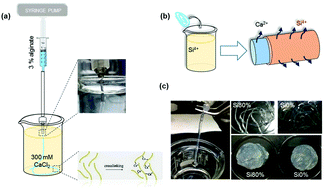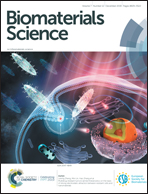Angiogenesis-promoted bone repair with silicate-shelled hydrogel fiber scaffolds
Abstract
Promoting angiogenesis is a key strategy for stimulating the repair of damaged tissues, including bone. Among other proangiogenic factors, ions have recently been considered a potent element that can be incorporated into biomaterials and then released at therapeutic doses. Silicate-based biomaterials have been reported to induce neovascularization through vascular endothelial growth factor signaling pathway, potentiating acceleration of bone regeneration. Here, we designed a silicate-shelled hydrogel fiber scaffold with a hard/soft layered structure to investigate the possibility of silicate coating on biopolymer for enhancing biological properties. An alginate hydrogel was injected to form a fiber scaffold with shape-tunability that was then coated with a thin silicate layer with various sol–gel compositions. The silicate/alginate scaffold could release calcium and silicate ions, and in particular, silicate ion release was highly sustainable for over one week at therapeutically relevant levels. The ionic release was highly effective in stimulating the mRNA expression of angiogenic markers (VEGF, KDR, eNOS, bFGF, and HIF1-α) in endothelial cells (HUVECs). Moreover, the in vitro tubular networking of cells was significantly enhanced (1.5 times). In vivo implantation in subcutaneous tissue revealed more pronounced blood vessel formation around the silicate-shelled scaffolds than around silicate-free scaffolds. The presence of a silicate shell was also shown to accelerate acellular mineral (hydroxyapatite) formation. The cellular osteogenesis potential of the silicate/alginate scaffold was further proven by the enhanced expression of osteogenic genes (Col1a1, ALP and OCN). When implanted in a rat calvarium defect, the silicate-shelled scaffold demonstrated significantly improved bone formation (2–3 times higher in bone volume and density) with a concurrent sign of proangiogenesis. This work highlights that the surface-layering of silicate composition is an effective approach for improving the bone regeneration capacity of polymeric hydrogel scaffolds by stimulating ion-induced angiogenesis and providing bone bioactivity to the surface.



 Please wait while we load your content...
Please wait while we load your content...